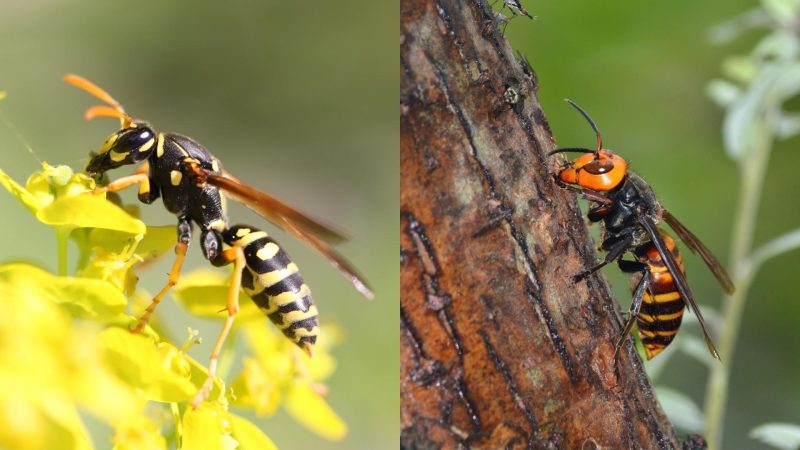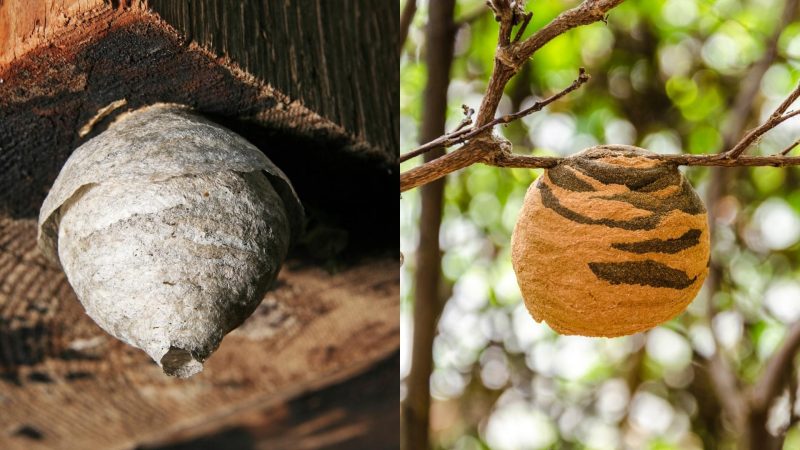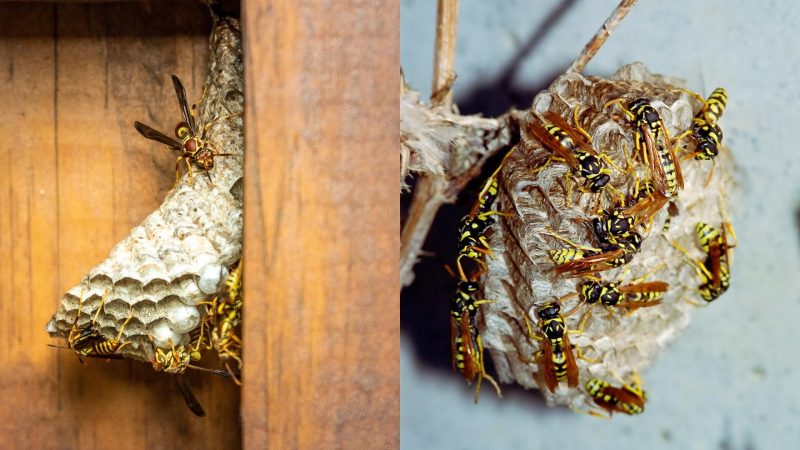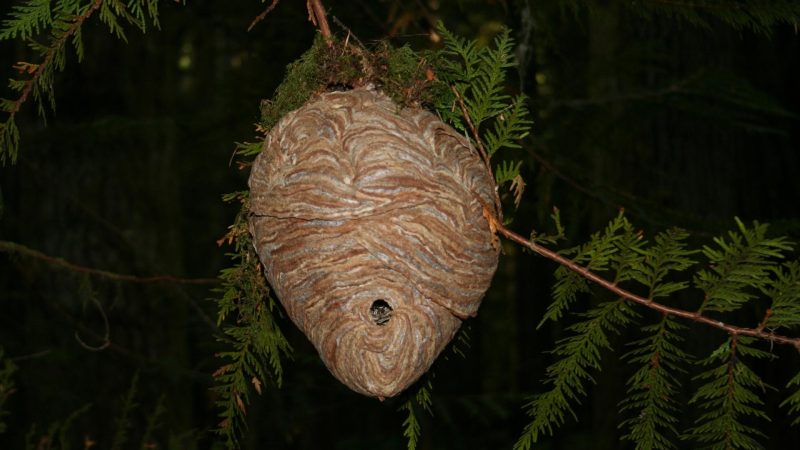Wasps and hornets are often mistaken for each other because they are somehow similar to each other. But then, these two insects also have some differences in appearance and how they build their nests. This is also why many people find it hard to tell if a nest is a wasp or a hornet nest if they see one.
So, what is the main difference between wasp and hornet nests? Depending on the species, a wasp nest is usually umbrella-shaped and has no external cover. On the other hand, a hornet’s nest looks like a piece of paper and is made from saliva and chewed wood fiber. It also has a protective hardshell cover.
Wasps and hornets build their nests near human habitats. Both of them have venom and will sting people who will try to disturb their nests.
They are also known to be more dangerous than bees. In this article, you will learn to identify a wasp nest, a hornet nest, and a yellow jacket nest and how to get rid of them.
How Dangerous Are Hornets and Wasps?
Because they frequently strike in huge groups and sting numerous times, hornets and wasps are among the more hazardous stinging pests. Not only are insect bites uncomfortable, but they can also result in potentially fatal allergic responses.
Your best chance if you see a hornet or wasp colony is to avoid it and never attempt to remove it yourself. This may agitate the insects and cause several severe, potentially fatal stings.
What Are the Similarities and Differences Between Wasps and Hornets?

Technically speaking, hornets are also wasps but are of specific types of wasps. Just like bees, they are also in the large order of insects called Hymenoptera. But unlike bees that have barbed stingers and die after they sting, these two species sting multiple times without dying since they don’t leave their stinger on the skin.
Appearance
The main difference between wasps and hornets is their appearance. Wasps are black, red, or yellow and can grow between 1/3 and 1 inch long.
On the other hand, hornets are black, brown, or reddish and can grow from 1/2 to 2 inches long. Nonetheless, both of them live in colonies. Therefore, they are called social wasps.
Aside from hornets, the two other most common types of social wasps are paper wasps and yellow jackets (or yellow jackets).
By the way, bald-faced hornets (Dolichovespula maculata) are not true hornets but are also social wasps. They are closely related to yellow jackets but are usually confused with paper wasps.
Paper wasps are usually reddish-orange to dark brown with yellow markings on their slender bodies. They can grow between 3/4 and 1 inch long and are slightly longer than yellow jackets.
Scientifically known as Polistes dominula, European paper wasps are a type of paper wasps that look similar to yellowjackets.
Nest Appearance
Hornets use the debris from chewing wood pulp to construct their nests. They may quickly assemble a sizable round or teardrop-shaped nest using their saliva to help tie the material firmly.
The hornet nests are gray or born in color since they are made of wood materials. On the inside, they have two to four horizontal combs and a single entrance. The exterior resembles a paper-mache piñata and is more streamlined and consistent than a conventional wasp nest.
While saliva and wood are both used to make paper wasp nests, scraps from logs, fences, or outdoor furniture are more frequently used. With hexagonal openings and no consistent cover, they have the structure of akin to paper.
Nest Size
Wasp colonies are substantially smaller than hive populations of hornets, and each hive needs its own nest. 200–400 bodies may be plenty for little hornet nests, while 700 workers are readily reached by bigger families.
Nests made by wasps are substantially smaller. The queen builds them from scratch each spring as a little home the size of a walnut. As the summer draws to a close, the nest becomes large enough to accommodate the growing wasp swarm.
The nests and colonies of paper wasps, for instance, are smaller. Between 20 and 30 individuals make up a paper wasp on average, with the number mostly depending on the climate and the wasps’ capacity for construction.
Normally, wasp nests only need to hold 25 adults, but during peak season, some swarms can reach 100 wasps or more in size.
Nest Location
Depending on the species you’re dealing with, you can determine where a hornet nest is.
- European Hornets – They favor openings in the walls as well as bushes and tree limbs. Additionally, they have been observed settling in crawl spaces, attics with undamaged rafters, and under siding of houses.
- Giant European Hornets – They ensure that they are kept as far away from sunshine and humidity as they can.
- Asian Giant Hornets – They create underground nests either by digging their own tunnels close to decaying tree roots or stealing ones created by other animals.
On the other hand, some wasp species, like hornets, like particular areas.
- Paper wasps – They favor open spaces like tree stumps, eaves, or crevices in buildings. They frequently resemble miniature umbrellas dangling from above and can fit in smaller spaces.
- Cicada Killers – They favor moving into trees that serve as cover for their prey,
- Spider Wasps – They bury themselves underground.
- Mud Daubers – They construct the solitary tubal nests inside of buildings such as barns and garages.
Paper Wasp Nest vs. Hornet Nest

Paper wasp nests are made of paper pulp and have a single comb of a cell without any protective shell.
These cone-shaped nests are usually found hanging on eaves of houses or buildings, support beams in attics, barns, garages, storage sheds, and other locations that are quite far from human intervention.
Overwintering wasp queens begin building nests in the early spring and lay a single egg inside. These nests are usually smaller than hornet nests and only have about 25 adult wasps.
Nonetheless, they can have about 100 wasps during peak season. In the late summer, population growth inside the nest slows down.
On the other hand, hornet nests are gray to brown, round or pear-shaped paper, with a thick, multilayered outer shell.
These paper-like nests have 2 to 4 horizontal combs inside and one entrance hole at the bottom, where hornets come in and out. Each nest typically contains a colony of 200 to 400 adults.
Hornet nests are about 3 inches long and mostly built above the ground. Just like wasp nests, they are also attached to a tree branch, utility poles, and shrubs.
In some cases, these paper nests are displayed in schools, natural history museums, nature centers, and houses, where they are being taken care of.
Yellow Jacket Nest vs. Paper Wasp Nest

A yellow jacket nest is mostly made of wood fiber and looks like paper. Like wasp nests, they also have an entrance hole where workers go back and forth.
Meanwhile, yellowjacket nests are entirely covered with a protective shell and can reach up to 6 feet long or longer. Only a few of them are shorter than 1 foot.
Each yellowjacket nest has about 45 combs of vertical cells and can house from 5,000 to 20,000 adults and workers, depending on the species.
As the queen continues to produce more eggs, workers will moisten the soil and dig more to make their nest bigger. They don’t go far from the nest when searching for food.
Interestingly, yellow jacket nests are commonly found on the ground, especially in flower beds, gardens, pasture fields, parks, near rodent burrows, and around garbage cans.
When compared to wasp and hornet nests, they can also be aerial nests and can be seen in open garages, under eaves, and in other safe elevations.
Hornet Nest vs. Wasp Nest vs. Yellowjacket Nest
Comparing the three nests to each other, all of them may emerge in warmer months such as April or May. Like the nest of a yellowjacket and hornet, a wasp nest lasts only for a year and will not be reused.
Almost all their workers will die in the winter, and the surviving fertilized queens will build new nests from scratch.
Hornet nests are bigger than wasp nests and contain more individuals. Hornet stings can be extremely painful as compared to yellowjacket and wasp stings.
However, hornets are generally not as aggressive as wasps and yellowjackets. They rarely attack humans unless you threaten them or disturb their nests.
Methods for Removing Hornet or Wasp Nests
The following are the best techniques for getting rid of hornet or wasp nests:
1. Hornet and Wasp Spray
Use a spray designed to kill hornets and wasps, and make sure to follow the directions on the can. Whenever as possible, aim for the entryway. Then, leave the spray on all night. Before you destroy the nest, keep an eye on the nest for the following two days to ensure that everyone has died.
As soon as you finish handling, clean your hands thoroughly with soap and water to remove any possible spray residue.
- KILLS ON CONTACT: Hot Shot Wasp and Hornet Killer controls wasps,...
- UP TO 27 FOOT JET SPRAY: With a jet spray that reaches up to 27...
- NON-STAINING: This product is non-staining to most home siding...
- FOR OUTDOOR USE: Apply at sunset when insects are least active
- INSECTS KILLED: Kills wasps, hornets and yellow jackets, as well...
- UP TO 27 FOOT JET SPRAY: This product has up to a 27 foot jet...
- NON-STAINING FORMULA: This product is non-staining to most home...
- Before using in areas where the spray may contact home siding,...
- Kills the entire nest.
- Contains In-Wash Pre-Treaters with Active Stain lifters for great...
- Safe to use in any washing machine and at any water temperature
- Kills wasps & hornets on contact.
- Residual action kills new wasps and hornets returning to nest.
2. Dust
In the evening, while using your safety gear, spray it on the entrance to the nest. Then, leave for a couple of days. As they move about and interact with other wasps, they will gather up any dust and transfer it to others.
- Delta Dust Bed Bug Insecticide - 1 lb.
- Yield: 1 lb. of Delta Dust covers about 2,000 sq.ft.
- Target Pest: Ants, Bed Bugs, Boxelder Bugs, Cockroaches,...
- Active Ingredient: Deltamethrin, 0.05%
- Cannot ship to NY or CT.
- Package Dimensions: 17.018 H x 3.302 L x 4.572 W (centimetres)
- Package Weight: 0.272 kilograms
- Country of Origin : United States
- Power source type: Manual
- Premium USA Supply Gloves with USA Supply ReSist Technology
- USA Supply Pest Identifcation Card
3. Dish Soap and Water
Although it is not as efficient as insecticide dust or spray, a quarter cup of dish soap diluted in a liter of water can be used as an alternative.
Put the mixture in a hose-end spray bottle and spray the spot for ten to fifteen seconds if the nests are hanging. This puts you away from and ought to have the strength to get inside the nest, perhaps suffocating them.
4. Drowning
Use a large fabric bag (such as a pillowcase) to swiftly cover the nest after filling a large bucket of water before putting it below. Put the fabric in the bucket after securing the top with twine or a zip tie.
Leave it for however long you require to feel comfy after securing the lid. The majority will perish over night, but staying longer is not harmful.
5. Smoke
Another method of eliminating an aerial wasps’ nest without using pesticides is by using smoke. All you have to do is light a tiny flame in the grill that is situated just beneath the nest. The wasps will be compelled to leave their nest as a result of being choked.
It is advised to wait a few hours for the odor of smoke rising to ensure the nest is unoccupied. Use a dish soap and water solution to get rid of the pests if they are still there. y can also be treated using this technique.
How to Get Rid of YellowJacket and Wasp Nests?
Like hornets, yellowjackets and wasps also sting humans repeatedly and can cause sudden pain and skin irritation.
Therefore, if their nests are far from you, ignore them. But if they are in a high-traffic area, such as near your doorways, you should already take action. Here are some tips to get rid of their nests:
- If you have a heart condition or you are allergic to stings, don’t try to disturb the nests alone. Instead, ask for help from a pest management professional.
- If you plan to treat the nests, do it during the early morning or late evening. These are the times they are least active, and you are less likely to get stung.
- Before treating them, wear protective safety glasses and gloves, a long-sleeved shirt, long pants, shoes, and socks that can be pulled over your pants.
- If you spot some yellowjackets coming out from their nest, you can put some traps such as RESCUE! Reusable Yellowjacket Trap . This product is also effective against wasps.
- If wasp nests are exposed, use a non-toxic aerosol spray specifically labeled for them, such as EcoSMART Organic Wasp and Hornet Killer .
- For yellowjacket nests that are hidden underground, apply insecticide dust on the entry point. Products such as Delta Dust Multi Use Pest Control Insecticide Dust work well not only against yellowjackets but also other pest insects.
- For nests on wall cracks and crevices, you may use an insecticide liquid spray that contains permethrin such as Durvet Permethrin 10%, 8oz . Note, however, that dust insecticides are more effective than liquid ones.
- A 2012 study revealed that some essential oils can repel social wasps. This includes essential oil from citronella, clove, geranium, lavender, rosemary lemongrass, and peppermint.
- To help prevent them from coming back the following year, destroy or remove abandoned nests.
Related: Yellow Jacket Control: How To Get Rid of Yellow Jackets?
How to Get Rid of Hornet Nests Without Getting Stung?

As mentioned earlier, hornet nests are also annual nests and usually emerge in the summer. All occupants will start to die of old age when the fall season starts, and they will freeze to death in the winter. But if you cannot wait for them to leave their nest, here are some ways to get rid of hornet nests safely and effectively:
- If you decide to treat a hornet nest, wear protective gear, clothes, and shoes.
- For nests that are on very high elevations, use a long-distance spray and stay off the ladder.
- Spray an insecticide directly on the nest entrance if you intend to use one.
- If you apply a liquid insecticide such as Durvet Permethrin on a ground nest, have a safety distance of several feet away.
- If you are not sure whether it is a hornet nest, a yellow jacket nest, or a wasp nest, use RESCUE! WHY Trap for Wasps, Hornets, & Yellowjackets .
- Don’t destroy or remove the nest until all of them are dead. Otherwise, the surviving hornets will disperse and are very likely to sting you.
- Typically, it takes 2-3 days before insecticides fully take effect. In most cases, you have to spray repeatedly to kill all of them inside the nest.
- Interestingly, hanging fake wasp nests such as AIRCROW Wasp Out Fake Hornet's Nest Decoy Wasp Deterrent also work. Wasps are territorial insects, and an artificial nest will discourage them from building one.
- For severe hornet infestations, it’s always better to hire a pest control service than do it yourself.
Related: How To Get Rid of Hornets Nest? | A Complete Guide
List of Sources
Krans, R. (2021). Bee, wasp or hornet nest: Which one is it? Michigan State University Extension.
Social Wasps. Iowa State University.
Moore, G. C., Merchant, M. E. (2003). Paper Wasps, Yellowjackets and Solitary Wasps. Texas A&M AgriLife Extension.
Zhang, Q.H., Schneidmiller, R.G., Hoover, D.R. (2012). Essential oils and their compositions as spatial repellents for pestiferous social wasps. Pest Management Science.
- How to Get Rid of Cockroaches? | Proven Strategies & Solutions! - June 24, 2023
- Powerful Homemade Wasp and Bee Sprays (with Recipes) - March 4, 2023
- Crazy Ants Invasion | Eradicate & Prevent Unwanted Guests - February 24, 2023






